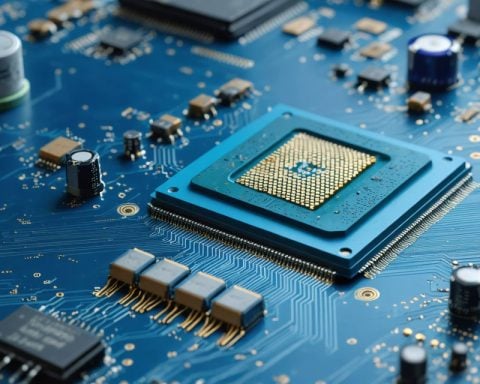According to industry analysis firm TrendForce, the near-eye display market for VR/MR devices is set to witness a fierce competition between OLEDoS and LCD technologies. While OLEDoS is expected to dominate the high-end segment, LCD will continue to maintain a stronghold in the mainstream market.
OLEDoS is gaining momentum in the high-end VR/MR market, with an anticipated market share of 23% by 2030. This can be largely attributed to the collaboration between Sony and Apple on the Apple Vision Pro, which has brought attention to the industry’s focus on high-resolution VR/MR devices. OLEDoS achieves higher luminous efficiency by using CMOS and top-emitting OLED components, pushing the basic resolution of its products to over 3,000 PPI. However, the complexity of CMOS manufacturing and its lower yield rates result in higher production costs, limiting the growth of OLEDoS penetration.
In addition to international companies, Chinese manufacturers like SeeYa and BOE are also investing in OLEDoS technology, which is expected to drive its expansion in the VR/MR device market. This investment aims to reduce costs and improve yield for CMOS technology. TrendForce projects that OLEDoS will increase its market share from 7% in 2024 to 23% in 2030.
On the other hand, LCD technology continues to dominate the mainstream near-eye display market due to its cost-effectiveness. However, as demand for higher resolution and image quality increases, LCD products with their 1,200 PPI will face competition from other technologies. TrendForce suggests that optimizing complex components like liquid crystal materials and backplane technology will help LCD maintain its competitiveness. BOE, a Chinese manufacturer, has been investing heavily in LCD technology for VR/MR devices, ensuring its strong position in the mid-to-low-end market. TrendForce predicts that LCD technology will hold a 63% market share by 2030.
In contrast, OLED technology, while flexible and capable of achieving high contrast ratios, is less competitive in the high-end market due to its limitations. OLED’s cost-effectiveness is overshadowed by LCD products, and its long-term penetration rate is restricted to specific manufacturers. TrendForce estimates that OLED’s market share in the VR/MR market will remain between 13% and 15% from 2024 to 2030.
As the VR/MR market continues to grow, the competition between OLEDoS and LCD technologies intensifies. While OLEDoS aims to capture the high-end segment with its superior resolution, LCD technology will strive to maintain its dominance in the mainstream market through continuous optimization and cost-effectiveness.
Additional Facts:
– OLEDoS stands for Organic Light-Emitting Diode on Silicon, which is a display technology that combines OLED and CMOS (Complementary Metal-Oxide-Semiconductor) technologies.
– LCD stands for Liquid Crystal Display, which is a display technology that uses liquid crystal molecules to control the passage of light through a screen.
– CMOS manufacturing refers to the process of fabricating integrated circuits using CMOS technology, which is widely used in the semiconductor industry.
– PPI stands for Pixels Per Inch, which measures the pixel density of a display.
– BOE is a Chinese manufacturer that specializes in display technologies and is investing in both OLEDoS and LCD for VR/MR devices.
– Apple and Sony have collaborated on the Apple Vision Pro, a high-resolution VR/MR device that showcases the potential of OLEDoS technology.
Key Questions:
1. What is the expected market share of OLEDoS in the high-end VR/MR market by 2030?
– OLEDoS is expected to have a market share of 23% by 2030.
2. What are the advantages of OLEDoS technology?
– OLEDoS achieves higher luminous efficiency by using CMOS and top-emitting OLED components, leading to high-resolution products with over 3,000 PPI.
3. What are the challenges for OLEDoS technology?
– The complexity of CMOS manufacturing and lower yield rates result in higher production costs, limiting the growth of OLEDoS penetration.
4. What Chinese manufacturers are investing in OLEDoS technology?
– SeeYa and BOE are Chinese manufacturers investing in OLEDoS technology.
5. What is the expected market share of LCD technology in the near-eye display market by 2030?
– LCD technology is predicted to hold a 63% market share by 2030.
6. What advantages does LCD technology offer?
– LCD technology is cost-effective and dominant in the mainstream market due to its affordability.
7. What are the limitations of OLED technology?
– OLED technology is less competitive in the high-end market due to its cost-effectiveness compared to LCD products. Its long-term penetration rate is restricted to specific manufacturers.
Advantages of OLEDoS:
– Higher luminous efficiency
– High-resolution display
– Potential for collaboration with industry-leading companies like Apple and Sony
Disadvantages of OLEDoS:
– Higher production costs due to the complexity of CMOS manufacturing and lower yield rates
Advantages of LCD:
– Cost-effective compared to OLED
– Dominant in the mainstream market
– Continuous optimization potential through complex component improvement
Disadvantages of OLED:
– Less competitive in the high-end market
– Limited cost-effectiveness
– Limited penetration rate compared to LCD
Suggested Related Links:
– TrendForce (Industry analysis firm mentioned in the article)



















